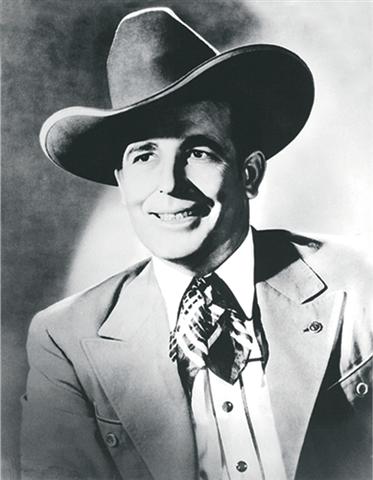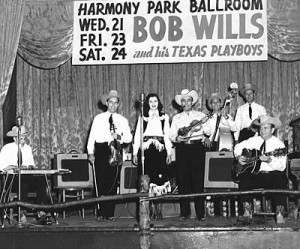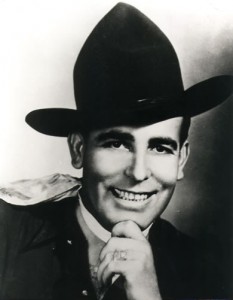
From Wikipedia:
“James Robert Wills (March 6, 1905 – May 13, 1975), better known as Bob Wills, was an American Western swing musician, songwriter, and bandleader, considered by many music authorities one of the fathers of Western swing and called the King of Western Swing by his fans.
“He was born in Limestone county near Kosse, Texas to Emma Lee Foley and John Tompkins Wills. His father was a statewide champion fiddle player and the Wills family was either playing music, or someone was always wanting us to play for them, in addition to raising cotton on their farm.
“The young Jim Bob learned to play the fiddle and the mandolin. Both a sister and several brothers played musical instruments, while another sister played piano. The Wills frequently held country dances in their home, and there was dancing in all four rooms. They also played at ‘ranch dances’ which were popular in both West Texas and eastern New Mexico at the time the Wills lived in Hall county.
“The family had moved to Hall county in West Texas about 1913. As a young man “Jim Rob”, as he was then known, drifted for several years, hopping freight trains and traveling from town to town to try and earn a living. In his 20s he attended barber school, got married, and moved first to Roy, New Mexico then returned to Hall county and Turkey, Texas (now considered his home town) to work as a barber at Hamm’s Barber Shop. He alternated barbering and fiddling even when he moved to Fort Worth as he left Hall county in 1929. There he played in minstrel and medicine shows, and, as with other Texas musicians such as Ocie Stockard, continued to earn money as a barber. He wore blackface makeup to appear in comedy routines, something that was common at the time. “He was playing his violin and singing.” There were two guitars and a banjo player with him.
“Bob was in blackface and was the comic; he cracked jokes, sang, and did an amazing jig dance.” Since there was already a “Jim” on the show, the manager began calling him “Bob.”
“Wills recalled the early days of what became known as Western swing music, in a 1949 interview. “Here’s the way I figure it. We sure not tryin’ to take credit for swingin’ it.” Speaking of Milt Brown and himself working with songs done by Jimmie Davis, the Skillet Lickers, Jimmie Rodgers, and others, and songs he’d learned from his father, he said that “We’d pull these tunes down an set ’em in a dance category. It wouldn’t be a runaway, and just lay a real nice beat behind it an the people would get to really like it. It was nobody intended to start anything in the world. We was just tryin’ to find enough tunes to keep ’em dancin’ to not have to repeat so much.”
 “After forming a new band, The Playboys, and relocating to Waco, Wills found enough popularity there to decide on a bigger market. They left Waco in January of 1934 for Oklahoma City. Wills soon settled the renamed Texas Playboys in Tulsa, Oklahoma, and began broadcasting noontime shows over the 50,000 watt KVOO radio station. Their 12:30-1:15 p.m. Monday–Friday broadcasts became a veritable institution in the region. Nearly all of the daily (except Sunday) shows originated from the stage of Cain’s Ballroom. In addition, they played dances in the evenings, including regular ones at the ballroom on Thursdays and Saturdays. By 1935 Wills had added horn, reed players and drums to the Playboys. The addition of steel guitar whiz Leon McAuliffe in March, 1935 added not only a formidable instrumentalist but a second engaging vocalist. Wills himself largely sang blues and sentimental ballads.
“After forming a new band, The Playboys, and relocating to Waco, Wills found enough popularity there to decide on a bigger market. They left Waco in January of 1934 for Oklahoma City. Wills soon settled the renamed Texas Playboys in Tulsa, Oklahoma, and began broadcasting noontime shows over the 50,000 watt KVOO radio station. Their 12:30-1:15 p.m. Monday–Friday broadcasts became a veritable institution in the region. Nearly all of the daily (except Sunday) shows originated from the stage of Cain’s Ballroom. In addition, they played dances in the evenings, including regular ones at the ballroom on Thursdays and Saturdays. By 1935 Wills had added horn, reed players and drums to the Playboys. The addition of steel guitar whiz Leon McAuliffe in March, 1935 added not only a formidable instrumentalist but a second engaging vocalist. Wills himself largely sang blues and sentimental ballads.
“With its jazz sophistication, pop music and blues influence, plus improvised scats and wisecrack commentary by Wills, the band became the first superstars of the genre. Milton Brown’s tragic and untimely death in 1936 had cleared the way for the Playboys.
“Wills’ 1938 recording of Ida Red served as a model for Chuck Berry’s decades later version of the same song – Maybellene. In 1940 New San Antonio Rose sold a million records and became the signature song of The Texas Playboys. The song’s title referred to the fact that Wills had recorded it as a fiddle instrumental in 1938 as San Antonio Rose. By then, the Texas Playboys were virtually two bands: one a fiddle-guitar-steel band with rhythm section and the second a first-rate big band able to play the day’s swing and pop hits as well as Dixieland.
 “In 1940 Wills, along with the Texas Playboys, co-starred with Tex Ritter in Take Me Back to Oklahoma. Other films would follow. In late 1942 after several band members had left the group, and as World War II raged, Wills joined the Army, but received a medical discharge in 1943. “Wills also appeared in The Lone Prairie (1942), Riders of the Northwest Mounted (1943), Saddles and Sagebrush (1943), The Vigilantes Ride (1943), The Last Horseman (1944), Rhythm Round-Up (1945), Blazing the Western Trail (1945), and Lawless Empire (1945). According to one source, he appeared in a total of 19 films.
“In 1940 Wills, along with the Texas Playboys, co-starred with Tex Ritter in Take Me Back to Oklahoma. Other films would follow. In late 1942 after several band members had left the group, and as World War II raged, Wills joined the Army, but received a medical discharge in 1943. “Wills also appeared in The Lone Prairie (1942), Riders of the Northwest Mounted (1943), Saddles and Sagebrush (1943), The Vigilantes Ride (1943), The Last Horseman (1944), Rhythm Round-Up (1945), Blazing the Western Trail (1945), and Lawless Empire (1945). According to one source, he appeared in a total of 19 films.
“In 1945 Wills’ dances were outdrawing those of Tommy Dorsey and Benny Goodman, and he had moved to Fresno, California. Then in 1947 he opened the Wills Point nightclub in Sacramento and continued touring the Southwest and Pacific Northwest from Texas to Washington State. While based in Sacramento his radio broadcasts over 50,000 watt KFBK were heard all over the West.
“Still a binge drinker, Wills became increasingly unreliable in the late 1940s, causing a rift with Tommy Duncan (who bore the brunt of audience anger when Wills’s binges prevented him from appearing). It ended when he fired Duncan in the fall of 1948.
“Having lived a lavish lifestyle in California, in 1949 Wills moved back to Oklahoma City, then went back on the road to maintain his payroll and Wills Point. An even more disastrous business decision came when he opened a second club, the Bob Wills Ranch House in Dallas, Texas. Turning the club over to managers later revealed to be dishonest left Wills in desperate financial straits with heavy debts to the IRS for back taxes that caused him to sell many assets including, mistakenly, the rights to New San Antonio Rose. It wrecked him financially.
“While he did well in Las Vegas and other areas, and made records for the Kapp Records label, he was largely a forgotten figure — even though inducted into the Country Music Hall of Fame in 1968. A 1969 stroke left his right side paralyzed, and he died at age 70 of pneumonia in Fort Worth.
“Wills’ style influenced performers Buck Owens and Merle Haggard and helped to spawn a style of music now known as the Bakersfield Sound. (Bakersfield, California was one of Wills’ regular stops in his heyday).
“In 2004, a documentary film about the life and music music, entitled Fiddlin’ Man: The Life and Times of Bob Wills, was released by VIEW Inc.”
You can get more information at the offical Bob Willis website by clicking HERE.
If you have problems seeing the video below click HERE.
youtube::BCDG9NQx4Vc::
If you have problems seeing the video below click HERE
.youtube::rM50ZQpSSTY::
